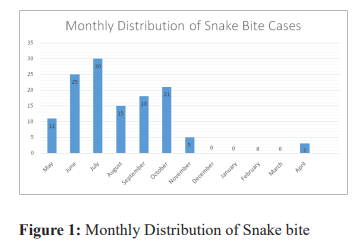Abstract
Introduction: Snake bite among adults is an
important public health and clinical problem in
many tropical and subtropical countries like Nepal.
There are limited studies found on snake-bite using
the WHO snake-bite management guidelines. This
study assessed the clinico-epidemiological profile
and their outcome in snake bite cases among
adults using the WHO/SEARO Guidelines for the
management of snake-bites.
Materials and methods: This is a descriptive study
among 128 adults admitted in Medical Department
of Western Regional Hospital from July 2018 to
June 2019 with the presentation of snake bite for
management.
Results: Around half (51.6%) of the cases were
female and the mean age was 39.3 years with standard
deviation of 16.6 years. Of the 128 patients, 7%
presented to hospital in first day, 32.8% in second
day, 31.3% in third day, and 17.2% on fourth day
and rest within ninth day of snake bite. Common
site of bite were left hand (38.3%) followed by
left leg (28.1%).Of the cases 81.3% developed
symptoms within first hour, 8.6% within sixth hour
and rest afterwards. Local site pain and swelling
was observed as most common sign/symptoms,
but there was no neurotoxic manifestations. Only
one (0.8%) patient needed Anti Snake Venom, two
(1.6%) needed injection Vitamin K and 22(17.2%)
needed Fresh Frozen Plasma (FFP) transfusion for
management of complication in addition to other
supportive measures. The case fatality rate was nil.
Conclusion: Using WHO Guideline for
management of snake bite in adults showed zero case
fatality rate in Western Regional Hospital. However
further studies need to be done by using national
and WHO guidelines among larger population and
area for better output and recommendation.
References
Tropical Diseases. https://www.who.
int/neglected_diseases/en/. Published
2010.
2. World Health Organization. http://
www.emro.who.int/health-topics/
tropical-diseases/. Republished
November 2020.
3. Hansdak S, Lallar KS, Pokharel
P, Shyangwa P, Karki P, Koirala
S. A clinico-epidemiological
study of snakebite in Nepal. Trop
Doct.1998; 28(4):223-6. https://doi.
org/10.1177/004947559802800412 .
4. Devkota UN SJ, Shah LN. Snakebite
in Nepal A study from Siraha District.
J Nepal Med Assoc. 2000; 39:203-9.
5. Shah KB, Shrestha JM, Thapa CL.
Snake Bite Management Guideline.
In: Department of Health Services,
EDCD, Kathmandu, Nepal. 2003. p.1-
32.
6. Bhetwal BB, O’Shea M, Warrel DA.
Snakes and snake bites in Nepal.
Tropical Doct. 1998; 28(4):193-5.
7. David William. World Health
Organization. WHO’s global strategy
for prevention and control of snake bite
envenomation. https://www.who.int/
health-topics/snakebite#tab=tab_1.
Published September 2019.
8. World Health Organization. https://
www.who.int/health-topics/snakebite.
Published July 2020.
9. Department of Health Services Nepal.
Annual-Report-Fiscal Year -2074-75
(2017/18).
10. Ghos S, Maisnam I, Murmu BK, Mitra
PK, Roy A, Simpson ID. A locally
developed snakebite management
protocol significantly reduces overall
anti snake venom utilization in West
Bengal, India. Wilderness & Environ
Med. 2008; 19:267-74.
11. Warrel DA. World Health
Organization /SEARO. Guidelines
for the management of snake-bites.
Published 2010.
12. Kulkarni ML, Anees S. Snake venom
poisoning: experience with 633 cases.
Indian Paediatrics. 1994; 31(10):1239-
43.
13. Poudel KM, Poudyal VP, Rayamajhi
RB, Budhathoki SS. Clinicoepidemiological profile and outcome
of poisonous snake bites in children
using the WHO treatment protocol
in Western Nepal. Journal of Nobel
Medical College. 2015; 4(1):21-
25. https://doi.org/10.3126/jonmc.
v4il.12811 .
14. Devkota UN, Steinmann JP, Kathayat
JB. Epidemiology of Snakebite A
study from Choharwa Army Camp,
Siraha, Nepal. J Nepal Med Assoc.
2001: 40(138):57-62. https://doi.
org/10.31729/jnma.835 .
15. Parrish H, Goldner J, Silberg S.
Comparison between snakebite in
children and adults. Pediatrics.1965;
36:251-6.
16. Timsinha Sidarth, Kar SM, Baral MP.
Epidemiology of Snake bite cases in
Manipal Teaching Hospital Pokhara.
MedPulse-International Medical
Journal. 2014; 1(5):222-26.

